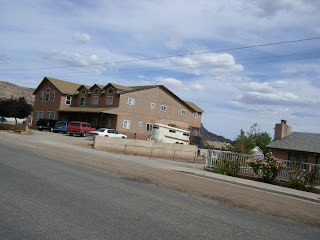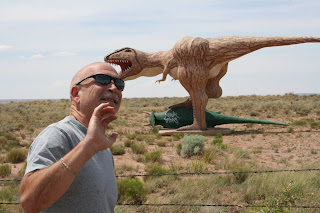

Tues, June 16, 2009
I woke up in St. George and grabbed my neat little Asus Eee PC (a 10.7 in screen, 160 gig hard drive, 7-hr battery life netbook) and headed for breakfast…coffee in particular. The second thing I do is to check the weather. Hmmm…well, today might be a “wet day.” And it was!
By the time Jes got up (“Papa, I swear it’s like a meat locker in here!” is her morning mantra) and we got going it, it was clear that the sky would not be. Rain garments went on top of the items in the saddlebags.
We ran north on Hwy 18 out of St. George, planning on stopping first at the
Mountain Meadows Massacre. It was, as before, a gorgeous drive, and intermittent light rain sprinkled us on the road.
Thirty miles later we pulled into the memorial sites, one of which is an overlook that has a memorial marking the names of those killed and several markers that provide the history of the tragedy. To make a long story short, an emigrant wagon train from Arkansas was ambushed by a group of Native Americans and Mormons from a local settlement. For reasons still not exactly clear, a Mormon militia joined in the attack. (This was during a time of the Utah War, when the US decided to assert its authority over the region and the Mormons resisted.)
After a day or so of continuous assault, a few people of the wagon train were killed and a “truce” was arranged in which the emigrants gave up their arms in exchange for a promise of safe escort out of the region. About a mile from the initial camp where the attacks began, the now-unarmed emigrants were slaughtered, save for all children under the age of seven (it was thought that they would not remember the incident).
Eventually, Brigham Young threw his son (one of them…nice to have some spares, no?) under the bus and who was eventually executed for this crime. Over time, the memorials were updated and improved.
The second memorial site was down in the meadows below the overlook and it contained the graves and stone cairn commemorating the burial site. It was really a beautiful place, one worth taking a side trip off the regular travel routes.


We decided to put on our rain pants in addition to our jackets we had already donned. The bad thing about riding a motorcycle when it’s wet is that if you wait till it’s raining to stop and put on rain gear, you’re doing so when the sky is dumping on you and it’s really too late.
Of course, along the way there were the usual stops for pictures. I love these that Jes took.


We made it to Cedar City on I-15 and took a look at the map. What the heck, we decided. We’d take the canyon road, Hwy 14, back to Hwy 89 (the road we had been on leaving Flagstaff.) and then head north. We were thinking that it would be too wet to ride the interstate up to Salt Lake City. On this account, we were truly correct, but we had hell still ahead of us.
As we rode up Hwy 14 heading east, I told Jes, “Well, it’s a canyon road…it might stay down low….unless, of course, the town was the bottom where the river ran out and we would be climbing to the mountains.” My words proved to be prophetic.
We climbed and we climbed. I pulled over and put my heavier pair of gloves on. We climbed. It rained on us…thank god not a downpour but a steady drizzle. Not much traffic. NO MOTORCYCLES coming the other way…definitely NOT a good sign.
Up, up, around and around…really pretty but really cold. By the time we pulled over at the junction between 143 and 14, it was about 40 something. I looked at the map and decided to take 143 where it led to 148 and then take the east turn down the mountains. This would put us up in the mountains a little longer, but drop us back onto 89 considerably further up the road. This decision was a mixed blessing, for we had a very rare view at one overlook, but we spent more time in the rain and cold.
And we continued up. Then, we saw snow alongside the road, which brought laughs. By now, we’re at 35 degrees. We really aren’t cold except for our hands, and it’s kind of important for a cycle rider to be able to work the hand controls, you know.
We stop at a pull out in which there was a viewing area overlooking a part of the mountain that seemed to have just sheared away, much like a tooth will break from the crown down to the root. (I’ve got to look that up on the net later.)

We get back on and continue climbing. We saw one sign that gave the altitude at just below 10,000 feet, but the road climbed for quite some time after that. I had to stop a couple of time just to take my gloves off and blow on my hands.
Once we crossed the summit and started down, the needle on the thermometer mounted on the bike started climbing….we were descending into heaven, I’ll say.
In town, we stopped for an afternoon snack and to get hot chocolate. I checked the map and we talked. It was clear that monsoon season in Utah was going to dump rain on the west side of the mountains we had just crossed, so we decided to go east, stay the night on I-70, then head to Moab the next day.
We saddled back up and motored the next 70+ miles north on 89. The road was nice, we had a wind in our back so I set that little puppy on 70 and let ‘er thunder down the road. A Harley big twin with the right pipes creates such a wonderful sound…not too loud yet you hear those big pistons just pounding away, their stale breath coming out through the exhausts in a steady, muted roar. It’s easy to get into a Zen state where your thoughts wander as the vista unfolds.
We turned east on I-70, got to Richfield and decided to make it an early day.
Great hotel, wonderful pool (it feels so good to get some exercise after a day on the bike...and it is NOT a good thing that I float better than I used to), dinner, movie, talk, bed.
I love my daughter!!!!
Mike Sledge


















































